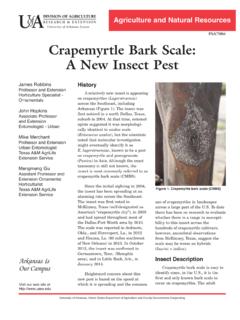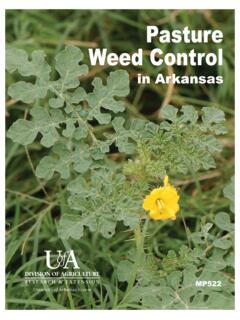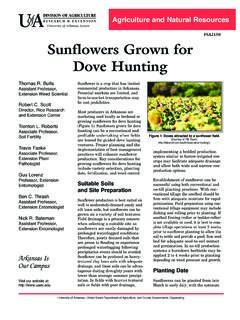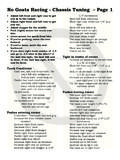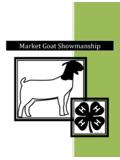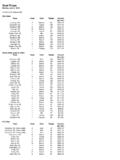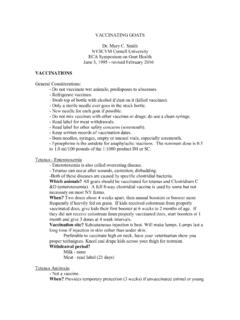Transcription of Managing and Showing Market Goats - FSA3121
1 DIVISION OF AGRICULTURE R E S E A R C H & E X T E N S I O N University of Arkansas System Agriculture and Natural Resources FSA3121 Managing and Showing Market Goats Steven M. Jones Associate Professor Animal Science Arkansas Is Our Campus Visit our web site at: Introduction The purpose of this fact sheet is to provide information to leaders, parents and club goat feeders for the develop ment of successful youth goat projects. Youth goat projects for youngsters are growing in popularity every year; con sequently, the competition is becoming greater every year.
2 Since Goats are small, easy to work with, relatively safer for smaller youth than larger animals and demand a relatively small amount of space, many 4 H and FFA members have discovered that Goats are an excellent choice as a project. Goats provide a meaningful livestock experience in a relatively short time. General Once a 4 H member has decided to have a goat project, there are several questions that must be answered before he/she begins. It is the responsibility of each exhibitor to read the general rules and regulations as well as special rules governing the shows to be attended. This will tell the number of Goats you can enter, weight limits, ownership dates and entry deadlines. The date of the show is extremely important because this determines the age and size or weight of the Goats and at what time of year they should be purchased.
3 Most shows require that Goats have their milk or baby teeth at show time. Goats will usually hold their milk teeth until they are 10 to 12 months of age, but this time can vary. After this time, you are risking that a goat will lose its baby teeth, thus making it ineligible. Under normal conditions, Goats will gain approximately 2 to pounds per week. Feed conversion with Goats varies greatly, but it usually ranges from 4 to 6 pounds of grain for a pound of gain. There are differences in frame size, and not all Goats can be fed to the same final weight. Large frame Goats may be correctly finished at 120 pounds, while small frame Goats may be cor rectly finished at 80 pounds. Learn to look at indicators of frame size and growth (length of head, neck and cannon bone) to determine at what weight a goat will be correctly finished. If you know at the time of purchase approximately what your goat weighs and how long it is until show time, you can calculate if a goat will have to be fed at a light, moderate or heavy rate to meet the weight limit requirements of the show you want to enter.
4 Remem ber that size does not make a good goat . There are good small Goats and good big Goats . Your management program is the key. Larger Goats are going to be more competitive for grand champions if properly finished. Facilities and Equipment One of the major advantages of a goat project is that young people can feed Goats without having expensive facilities and, with proper precautions, have little danger of getting severely injured. A barn or shed where Goats can retreat from cold, wet conditions and outside exposure is all that is necessary. Following is a discussion of the facilities and equipment needed for a goat project. It should be under stood that a young person with a couple of Goats for a local or county show would not necessarily need all of the equipment listed. University of Arkansas, United States Department of Agriculture, and County Governments Cooperating Barns and/or Sheds Goats need a combination arrangement: access to a shed and an area where they can get away from or stand in the sunshine.
5 The shed area should have at least 15 square feet of space for each goat . Gener ally, the pen should be at least 4 feet by 6 feet. The outside pen needs to be as big as possible to allow the goat to exercise. Some youth have a jump between the feed and water to develop muscle in the Goats . The shed should be well drained so water does not accumulate underneath. Sheds or barns normally, but not always, should open to the east or south. Barn temperature is critical. Structures should be well ventilated so Goats will remain cool and continue to grow during the summer months. Pen Fences Fence height should be at least 42 inches tall, preferably 48 inches tall, to keep Goats from attempt ing to jump and should be predator proof. If you are using net wire fences, use 12 inch mesh rather than 6 inch mesh to keep Goats from getting their heads hung.
6 However, the most desirable pens are con structed from galvanized livestock panels that are 52 inches tall with 4 inch squares. Feeders Self feeders are often used in the feeding of Goats . Self feeders for Market Goats of more than 30 pounds should be blocked up at least 16 inches off the ground, preferably higher, to keep feces out of the trough. Hand feeding of Goats should be done in movable troughs that hang on the fence at the appro priate height. Troughs should be hung at the same height as the top of the shoulder of the Goats being fed. These movable troughs need to be taken down and cleaned regularly. Leads with a snap can be used to separate Goats wearing halters. Likewise, hay and mineral feeders need to be raised off the ground. This will help reduce the spread of disease, especially internal parasites. It is also important to make sure Goats are unable to stand in their feed trough, as they will urinate or defecate on the feed.
7 Water Containers Clean water is the most important ingredient forfeeding Goats . Goats should not be allowed to defe cate in the water, and the water should not be a source of disease. Water troughs should be small so they can be drained and cleaned on a regular basis. Remember that water troughs should be checked on a daily basis. Water troughs should be located in the shade to keep water cool. However, in the hot summer months, some Goats tend to drink too much water and appear full. Water should never be totally removed for the goat , but rationing water prior to a show will help remove the belly from the goat and increase the goat s chances in the show ring. Remember, do not dehydrate your goat . The proper amount of fluids is vital to the feel and condition of your goat . Necessary Equipment The following list of equipment is considered necessary for feeding and exhibiting Goats .
8 You may share some of the equipment with other members of your club, chapter or team. In most cases, it is better to share equipment to see how you like it before investing in equipment. Shovel or rake to clean pens occasionally Scales to weigh Goats (bath scales work.) Trimming table with the following dimensions: 45 inches 20 inches 18 inches tall Hoof trimmers Electric clippers are necessary but can vary. Options include: 1) classic sheep and goat clippers with 20 and 23 tooth combs and 4 point cutters, an all purpose blade (close to the skin) and plucking blade (leaves 3/8 inch), 2) small animal grooming clippers with detachable blades for varying lengths of hair, 3) newer model lightweight clippers with blades for both fine and medium cuts and/or 4) classic cattle clippers with surgical and medium blades.
9 Many exhibitors elect to spend more money for the newer lightweight clippers that have less vibration and closer teeth so youth can use the clippers more easily and with greater safety. Syringes and needles for injections goat blankets and/or socks Halters, collars and/or show chains Some medical supplies Optional Equipment The following additional equipment is often acquired by families who feed several Goats and exhibit Goats at several major shows. The equipment might be shared by a group of 4 H or FFA members. Showbox to hold equipment Hot air blower or dryer Portable livestock scales Extension cords Electric fans Selection The selection of a goat for a project is one of the most important decisions made by a feeder. The type of goat you select at the beginning of the project will have a major influence on the results at the end of the project.
10 However, you must remember that a winning goat is a combination of good selection, good nutritional management, proper grooming and outstanding showmanship. People differ in their ability to select prospective animals (Figure 1). Some have a natural eye for selecting young animals, while others never develop this ability. Do not hesitate to take advantage of a person with these skills. It may be your county Extension agent, FFA instructor, parents or another leader in the county. Also, many breeders are willing to assist you in your selection program. Judges also differ slightly in the type of goat they prefer. In more competitive shows, more stylish Goats and Goats that are the best prepared and presented will place higher when all have the same amount of muscle. Figure 1. Young Goats are often selected to one goat to another to determine its goodcharacteristics.






